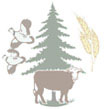Eastern Red Cedar
Eastern redcedar (Juniperus virginiana L.) is a member of the cypress family (Cupressaceae) native to the forests of the eastern and central United States. Because this species tolerates extremes of drought, heat and cold, the natural range extends well out into the Great Plains. Eastern redcedar thrives on thin limestone soils and will successfully invade abused, overgrazed sites, abandoned pastures, and limestone rock exposures. The species has proliferated over the past 50 years due to land conversion, overgrazing, land abandonment and fire suppression. Many landowners have a negative view of eastern redcedar, perceiving it as an invasive weed species, often chained, bulldozed and burned. As the resource has spread and increased in age, its utilization and value in an array of products has become more widely recognized. The red, heartwood of eastern redcedar logs contains secondary metabolites or "oils" that possess the qualities to resist and/or repel insects and decay.
Eastern redcedar wood is used by builders and homeowners because of its durability, beauty, fragrance, resistance to insect infestation and decay, and ease of maintenance. It can also be used for almost any kind of furniture, especially for cedar chests and wardrobes and is commonly used in closets. As wood utilization by-products, shavings are widely used for large and small animal pet bedding and redcedar mulch distinguishes itself by its appealing color, aroma, durability and insect deterring properties1 . From an environmental standpoint, eastern redcedar is often used for wildlife habitat and in agroforestry practices for shelterbelt and windbreak plantings.
1 Suszkiw, J. 2000 Termites go hungry on resistant trees USDA ARS News & Information, http://www.ars.usda.gov/is/pr/2000/001012.htm Meissner H.E. and Silverman J. 2001 effects of aromatic cedar mulch on the Argentine Ant and the Odorous House ant (Hymenoptera: Formicidae), J. Econ. Entomol. 94(6): 1526-1531

